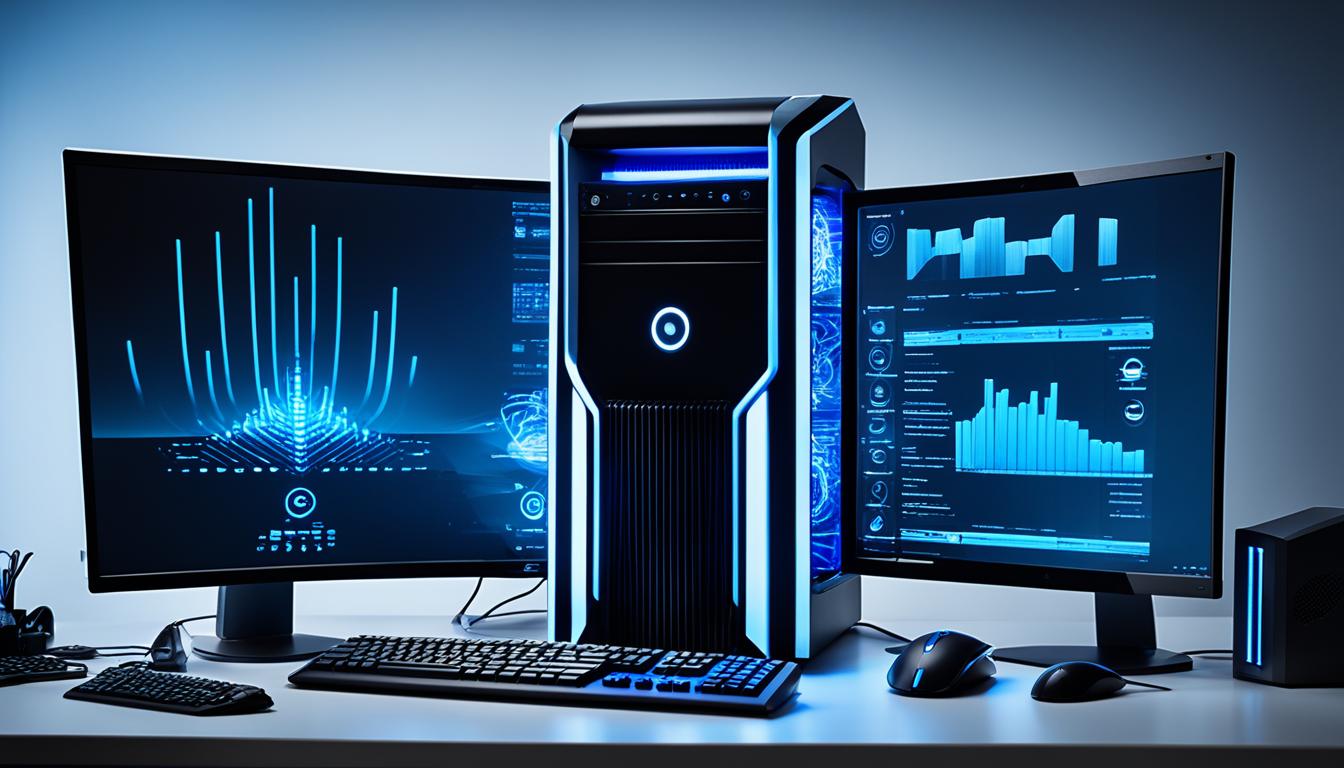Existing customer? Sign in
Understanding System Software Essentials

Did you know that system software is responsible for running a computer’s hardware and applications, managing its resources, and providing a platform for running application software? This essential piece of software is bundled with a computer’s operating system, such as Windows, Linux, MacOS X, or BSD. It plays a crucial role in optimizing system performance, ensuring software compatibility, and maintaining software configurations.
System software encompasses various components, including the operating system, device drivers, firmware, BIOS and UEFI, and programming language translators. Each of these elements contributes to the smooth functioning of a computer system, allowing users to perform tasks efficiently and effectively.
- System software is essential for running a computer’s hardware and applications.
- There are various components of system software, including the operating system, device drivers, firmware, BIOS and UEFI, and programming language translators.
- Understanding system software is crucial for optimizing system performance, ensuring software compatibility, and maintaining software configurations.
- Regular software updates, adherence to system requirements, and efficient configuration are necessary for a seamless computing experience.
Types of System Software
In the realm of computer systems, there are various types of system software that perform essential functions to keep everything running smoothly. Let’s explore the different categories:
Operating Systems
Operating systems are the backbone of any computer system, responsible for managing memory, processes, software, and hardware. Some popular examples of operating systems include Windows, macOS, and Linux. They provide the necessary interface for users to interact with their computers and ensure that all programs and hardware devices can communicate effectively.
Device Drivers
Device drivers play a crucial role in facilitating communication between the computer and its connected hardware devices. They act as intermediaries, translating commands from the operating system into signals that the hardware can understand. Without device drivers, important peripherals like printers, keyboards, and scanners would not function correctly.
Firmware
Firmware refers to the embedded software that controls specific hardware devices. It is typically stored in read-only memory (ROM) and is responsible for managing the device’s operations. Firmware is commonly found in devices such as routers, smartphones, and smart TVs. It ensures that the hardware performs optimally and provides essential functionalities.
BIOS and UEFI
BIOS (Basic Input/Output System) and UEFI (Unified Extensible Firmware Interface) are firmware codes that execute when a computer is powered on. They initialize the system and perform hardware checks to ensure everything is functioning correctly. BIOS has been superseded by UEFI, which offers more advanced features and improved security.
Programming Language Translators
Programming language translators are software tools that convert code written in one programming language into another programming language. There are various types of translators, including compilers, assemblers, and interpreters. They enable developers to write code in their preferred programming language and then translate it into a format that the computer can understand and execute.
Understanding the different types of system software is crucial in comprehending how computers operate and interact with their environment. Together, these software components enable seamless communication between hardware and software, ensuring the optimal functioning of computer systems.
Features of System Software
System software possesses several key features that contribute to its crucial role in managing a computer’s hardware and resources. These features include high speed, versatility, hard to manipulate, and closeness to the system.
High Speed
One of the notable features of system software is its high speed, which ensures efficient functioning of critical tasks. It enables the software to control the central processing unit (CPU), memory, and peripheral devices swiftly, optimizing system performance.
Versatility
System software exhibits versatility, allowing the user to run multiple programs simultaneously. This multifunctionality enhances productivity and enables efficient multitasking, catering to the diverse needs of users.
Hard to Manipulate
System software is designed to be hard to manipulate, safeguarding system settings and configurations. This feature prevents novice users from inadvertently altering critical system parameters, maintaining stability and preventing potential issues.
Closeness to the System
Another important characteristic of system software is its closeness to the system. Dependent systems are tightly integrated into the computer’s core, ensuring direct access to resources and facilitating seamless interaction between hardware and software. Independent systems, on the other hand, are separate entities that operate alongside the computer system but are not directly embedded within it.
System software’s high speed, versatility, hard to manipulate nature, and closeness to the system make it an essential component to ensure optimal system performance and efficiency.
With an understanding of the features of system software, it becomes evident how it plays a crucial role in managing computer systems effectively. The next section will delve deeper into the functions and importance of operating systems in the context of system software.
Operating Systems and Their Functions
Operating systems are responsible for managing a computer’s resources, ensuring efficient operations and providing a platform for running applications. They play a crucial role in handling tasks such as file management, process management, memory management, error detection, security, and control and management.
When it comes to file management, operating systems enable the creation, modification, and deletion of files, as well as their organization into directories and folders. This ensures that users can easily access and manage their data.
Process management involves the coordination and execution of multiple processes within the system. The operating system allocates resources, schedules processes, and manages their execution to ensure optimal performance and responsiveness.
Memory management is another key function of operating systems. They allocate and deallocate memory to processes, ensuring efficient utilization of available resources. This helps prevent memory conflicts and improves system performance.
In the words of computer scientist Andrew S. Tanenbaum, “Operating systems provide the illusion of infinite memory and infinite processors, that everything is always available.” This highlights the important role of operating systems in managing memory and resources effectively.
Error detection is an essential function performed by operating systems. They detect and handle errors and exceptions that occur during the execution of programs, preventing system crashes, data corruption, and other undesirable consequences.
Security is paramount in operating systems. They provide mechanisms to authenticate users, control access to resources, and enforce security policies. This safeguards the system from unauthorized access, malicious activities, and data breaches.
Finally, operating systems are responsible for the control and management of various programs and processes running on the computer. They monitor and control their execution, ensuring proper coordination and utilization of system resources.
Examples of Operating Systems
There are several popular operating systems available today, each with its own unique features and functionalities. Some notable examples include:
- Windows: Developed by Microsoft, Windows is a widely used operating system known for its user-friendly interface and broad compatibility with software and hardware.
- macOS: Developed by Apple, macOS is the operating system that powers Mac computers. It offers a seamless integration with other Apple devices and a sleek, intuitive design.
- Linux: Linux is an open-source operating system that is highly customizable and popular among developers and tech enthusiasts. It offers a high level of security and stability.
These examples showcase the diversity and widespread usage of operating systems in various computing environments.
Operating systems serve as the backbone of a computer system, efficiently managing its resources and providing a stable platform for running applications. Understanding their functions and features is essential for optimizing system performance, ensuring data security, and facilitating a seamless computing experience.
Conclusion
System software is a vital component in managing a computer’s hardware, resources, and applications. At the forefront of system software are operating systems, which serve as the foundation for running computer programs. These operating systems, including popular ones like Windows, macOS, and Linux, enable efficient memory management, process handling, and file management.
In addition to operating systems, device drivers play a crucial role in facilitating communication between a computer and its hardware devices. By acting as the intermediary, device drivers ensure seamless interaction and optimal performance. On the other hand, firmware serves as embedded software that directly controls the functionality of hardware components, often stored in a read-only memory (ROM).
To fully harness the potential of system software and achieve peak performance, it is essential to understand its features and functions. High speed, inherent complexity, and proximity to the system are key attributes of system software. The high-speed capabilities of system software allow for efficient execution of tasks, while the complexity ensures system settings and configurations are protected from unintentional manipulation. Furthermore, the close integration with the system provides accessibility to critical resources.
To maximize the benefits of system software, regular software updates, adherence to system requirements, and efficient configuration are essential. Keeping system software up to date ensures compatibility with the latest applications and security patches, safeguarding against potential vulnerabilities. Adhering to system requirements ensures optimal performance, while efficient configuration allows for tailored customization and improved user experience.
FAQ
What is system software?
System software is a program that manages a computer’s hardware and applications, providing a platform for running application software and managing system resources.
What are the types of system software?
The types of system software include operating systems, device drivers, firmware, BIOS and UEFI, and programming language translators.
What is the function of operating systems?
Operating systems manage a computer’s resources, such as memory, processors, and I/O devices. They perform tasks such as file management, process management, memory management, error detection, security, and control and management of other programs.
What is the importance of system software in system performance?
System software plays a crucial role in optimizing system performance by efficiently managing tasks, controlling the CPU, memory, and peripheral devices, and ensuring the seamless functioning of the computer system.
How does system software ensure software compatibility?
System software ensures software compatibility by adhering to system requirements and providing a platform for running different applications on various operating systems.
How can software configuration be maintained?
Software configuration can be maintained by regularly updating system software, adhering to system requirements, and efficiently configuring and managing software settings.
Why are software updates important for system performance?
Software updates are important for system performance as they provide necessary bug fixes, security patches, and performance enhancements, ensuring the smooth and optimized functioning of the system.
Source Links
- https://edu.gcfglobal.org/en/computerbasics/understanding-operating-systems/1/
- https://www.simplilearn.com/tutorials/programming-tutorial/what-is-system-software
- https://www.techtarget.com/whatis/definition/system-software




